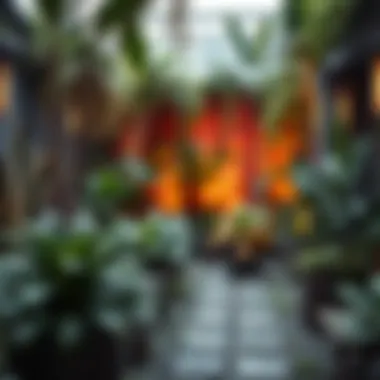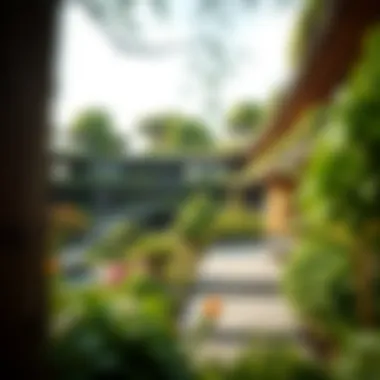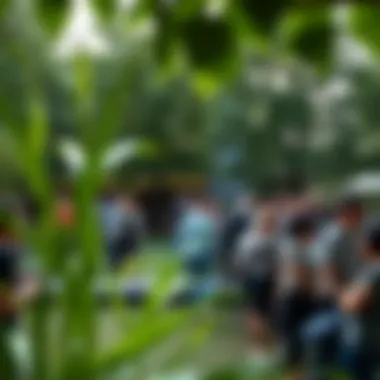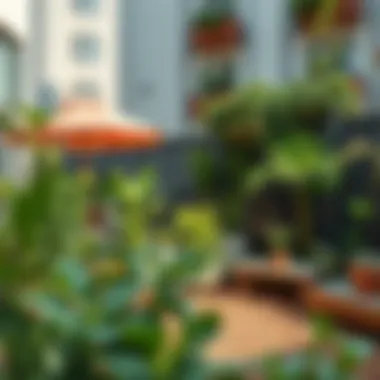Creating Urban Oases: Sustainable Spaces for All


Intro
Urban centers around the globe are bustling with life. But amidst the concrete jungles, the struggle to maintain touch with nature becomes evident. That's where the concept of oasis building comes into play, offering a breath of fresh air in the daily grind. By integrating green spaces into the urban fabric, we foster an environment where nature and architecture coexist harmoniously. This article delves deep into the art of creating these serene retreats, emphasizing not just their aesthetic appeal but their practicality in enhancing urban life.
The focus isn’t merely about planting trees and sprucing up parks. It’s about cultivating a deeper connection between communities and their surroundings.
When thought through properly, these oases can transform how we interact with our environment, providing not just relief from the hustle but a sense of belonging. From reducing urban heat island effects to promoting mental well-being, the benefits are multi-faceted.
As we dive into this exploration, we'll see how a well-planned oasis can be a game changer for urban planners, developers, and environmentalists—all looking to innovate in sustainable urban environments. Not only can these green spaces uplift the quality of life, but they also play a crucial role in boosting local economies and enhancing ecological resilience.
So, let's roll up our sleeves and uncover the various elements that make oasis building a fundamental aspect of modern urban planning.
Prelude to Oasis Building
Urban life can often feels like a sea of concrete, with greenery squeezed into every nook and cranny that’s left. This is where the concept of oasis building comes into play, acting as a breath of fresh air in environments that are often characterized by their density and chaos. Oasis building is not just about planting a couple of trees or installing some flower beds; it’s about crafting holistic spaces where nature and architecture coexist in harmony, providing sanctuary amidst the hustle and bustle of city life.
The importance of this subject cannot be overstated. An oasis in an urban setting can contribute significantly to individuals' wellbeing, offering a respite from the stresses of daily life. Studies show that access to nature can improve mental health, reduce stress, and promote social interaction among residents. Furthermore, these spaces often enhance the aesthetic appeal of neighborhoods, potentially increasing property values and attracting business.
Defining Oasis Building
The term "oasis building" encapsulates the art of integrating natural elements into urban environments. At its core, it’s about designing spaces that provide not just beauty, but also functionality and sustainability. This involves understanding the relationship between people, nature, and built environments. Oasis builders often incorporate elements such as green roofs, community gardens, and park spaces that allow city dwellers to connect with nature in meaningful ways. A well-planned oasis can range from lush parks filled with trees and plants to small urban pockets where locals can gather, engage, and breathe.
Historical Context
Looking back through the ages, humans have always sought ways to blend nature with habitation. The concept of an oasis carries a rich historical context. Ancient civilizations, such as those in Mesopotamia and Egypt, often established their settlements around areas where resources like water were abundant. These oases were crucial for their survival, providing necessary resources like food and hydration, as well as social spaces for community gatherings. As cities evolved over time, the notion of creating refuge-like green spaces fell by the wayside, replaced by prioritizing urban development and expansion.
However, recent trends show a resurgence in interest for these types of spaces as people recognize their value for enhancing quality of life in densely populated areas. Cities worldwide are increasingly adopting the principles of oasis building to create environments where nature isn’t just an afterthought but a fundamental aspect of urban planning.
"Oasis building is about embedding nature within the concrete jungles of our cities, reminding us that we can coexist with our environment."
In the following sections, we will delve deeper into the key principles of oasis design as well as explore practical applications and successful case studies, laying the groundwork for a future where urban landscapes can be both sustainable and vibrant.
Key Principles of Oasis Design
In the world of urban development, the concept of oasis design stands out as a transformative approach that marries nature with functionality. As cities swell with population and urban sprawl, creating these pockets of tranquility isn't just a luxury—it's becoming a necessity. Oasis design emphasizes principles that not only enhance ecological harmony but also improve human interaction and well-being. The exploration of this topic is crucial not merely for creating visually appealing spaces but for cultivating sustainable environments that foster community ties and environmental benefits.
Sustainability and Ecology
Biophilic Design
Biophilic design encapsulates the inherent human desire to connect with nature. This concept involves integrating natural elements into urban settings to enhance psychological and emotional well-being. Key characteristics of biophilic design include the utilization of natural light, organic shapes, and materials that reflect the natural landscape. By incorporating these elements, urban spaces become more inviting.
The main reason biophilic design is gaining traction is its proven benefits to mental health and productivity. A unique feature of this approach is how it reduces stress and anxiety leading to a better quality of life for city dwellers. However, one must also consider that biophilic environments can be costly to develop and maintain, presenting challenges for budget-conscious projects.
Natural Resource Management
Natural resource management is a critical aspect that ensures the sustainability of oasis building. This approach focuses on using natural resources efficiently, which contributes to the overall health of urban ecosystems. A standout characteristic of natural resource management is its ability to promote efficient water use and soil management practices. This is crucial in urban landscapes where resources are often strained.
Implementing natural resource management strategies such as water conservation and sustainable landscaping practices can lead to significant long-term savings. A unique feature is its adaptability to various urban contexts, allowing each project to tailor solutions based on local resources and conditions. Yet, despite these advantages, mismanagement can lead to unintended consequences, highlighting the need for thorough planning.
Community and Social Cohesion
Creating Shared Spaces
Creating shared spaces within urban environments is essential for fostering social cohesion. These spaces, whether parks, plazas, or community gardens, invite collective interactions and bring people together. A key characteristic of these shared spaces is their design, which encourages engagement and facilitates socializing among diverse groups.
The benefit of shared spaces is their ability to nurture relationships and reduce feelings of isolation among urban residents. For instance, incorporating benches, picnic areas, and activity zones creates an atmosphere of inclusivity. One downside, though, can be the conflict over space usage, which necessitates careful planning and community input to navigate successfully.
Fostering Interaction
Fostering interaction is fundamental for vibrant urban communities. This aspect highlights creating environments that encourage communication and social activities among residents. Key characteristics include designing areas that naturally lead to engagement and shared activities—from playgrounds and sports fields to cultural hubs.


The appeal of fostering interaction lies in its capacity to build trust and a sense of belonging among individuals from various backgrounds. It allows for the exchange of ideas and cultural practices, which enhances community identity. However, challenges may arise since not all interactions will be positive, underscoring the need for mediation strategies in conflict resolution to ensure harmonious environments.
Investing in oasis design principles unlocks the potential for vibrant, sustainable urban spaces, reshaping our cities into livable sanctuaries.
The Role of Water in Oasis Building
Water plays a critical role in the architecture of oasis building within urban environments. It is not only a fundamental element of natural ecosystems but also a powerful design feature that enhances both the aesthetic and functional qualities of urban spaces. The incorporation of water features can transform gray, lifeless areas into vibrant, inviting havens that attract wildlife and people alike. This section delves into the significance of water in oasis building, discussing design elements such as reflective pools and water gardens, along with sustainable water management practices like rainwater harvesting and greywater recycling.
Water Features as Design Elements
Reflective Pools
Reflective pools serve as artistic and tranquil design elements within urban oases. These pools are designed to mirror their surroundings, creating a visual connection with the architecture and landscape around them. The elegant stillness of the water can instill a sense of calm, providing an escape from the bustling urban environment. A key characteristic of reflective pools is their ability to invite light, making spaces feel larger and more open.
Benefits of incorporating reflective pools include:
- Visual Appeal: They enhance the aesthetic quality of the environment, adding a layer of beauty that can be both calming and engaging.
- Wildlife Attractant: These features can encourage local wildlife such as birds and butterflies to frequent the area, fostering biodiversity.
However, challenges exist with reflective pools. They require regular maintenance to prevent algae growth and ensure cleanliness, which can lead to increased costs over time. Overall, reflective pools represent a delicate balance between maintenance and the tranquility they offer.
Water Gardens
Water gardens function not just as visually striking focal points, but also contribute significantly to the broader ecological system. These gardens incorporate aquatic plants and animals, promoting biodiversity and creating mini-ecosystems within the urban landscape. A notable aspect of water gardens is their role in improving water quality. The plants help filter contaminants, providing cleaner water and combating pollution.
Key benefits include:
- Environmental Health: Water gardens improve local ecosystems by supporting various life forms, which can help maintain a balanced environment.
- Community Engagement: They invite community interaction through educational opportunities, showcasing the importance of water conservation and biodiversity.
However, like reflective pools, water gardens can demand significant upkeep. They require careful monitoring to maintain the health of aquatic plants and animals. Still, the return on investment in the form of community engagement and ecological benefits often outweighs these challenges.
Sustainable Water Management
Rainwater Harvesting
Rainwater harvesting is an innovative and effective approach to sustainability in oasis building. This method captures rainwater runoff which can then be stored for various uses, including irrigation for gardens and landscaping. A defining feature of rainwater harvesting systems is their ability to reduce dependency on municipal water supplies and alleviate stormwater management issues.
Advantages of rainwater harvesting include:
- Cost Savings: Over time, utilizing harvested rainwater can decrease water bills for property owners or developers.
- Environmental Conservation: It minimizes the pressure on natural water sources, contributing to overall water sustainability in urban areas.
However, there are some downsides such as the initial setup costs and the necessity for proper filtration and maintenance to ensure water safety for non-potable uses.
Greywater Recycling
Greywater recycling involves reusing water from household activities like bathing and laundry for irrigation and toilet flushing. It presents an opportunity to reduce water usage dramatically while promoting sustainability. The main characteristic of greywater systems is their capacity to treat and recycle water on-site for non-potable uses, thereby conserving precious resources.
Benefits of greywater recycling include:
- Resource Efficiency: It significantly reduces the overall water consumption of a project, making urban buildings more self-sufficient.
- Sustainable Living Education: These systems educate residents about resource management, encouraging a culture of conservation.
However, greywater systems require careful planning and management to ensure they comply with health regulations. If mishandled, there can be risks associated with the improper treatment of water.
Materials and Resources in Oasis Construction
In crafting sustainable sanctuaries within urban landscapes, the choice of materials and resources plays a pivotal role. It’s not just about aesthetics, but also about making choices that enhance the environment while fostering a sense of community. The focus on using eco-friendly materials and innovative construction techniques helps reduce the ecological footprint of these projects. By understanding the significance of materials that are both sustainable and functional, builders and urban planners can create oases that stand the test of time.
Eco-friendly Building Materials
Recycled Materials
Recycled materials are making waves in the field of construction, and for good reason. They represent a sensible choice for builders looking to lessen their environmental impact. Using materials that have already served a purpose reduces the need for new resources, essentially giving discarded items a second life in the construction world. Top characteristics of recycled materials include durability and versatility, as they can be transformed into everything from bricks to insulation.


One unique feature of recycled materials lies in their increased acceptance within the market. With a growing awareness of sustainability, many urban developers now prioritize these resources, driven by both environmental responsibility and cost-effectiveness. On the flip side, one must consider the quality variation among recycled products; not all recycled materials are created equal, and ensuring consistent standards can be a challenge.
"Using recycled materials is a step towards not just building structures, but also rebuilding our relationship with nature."
Locally Sourced Resources
When it comes to construction, using locally sourced resources is like hitting two birds with one stone. It fosters local economies while minimizing transportation emissions, which is crucial in reducing the overall carbon footprint. The key feature of locally sourced resources is their lower environmental impact during transport. Additionally, utilizing these materials often aligns with the cultural context of the area, making the construction feel more authentic and connected to the community.
A notable advantage of this approach is the support of regional suppliers and craftspeople, which can enhance the project's narrative and appeal. However, depending on location, accessibility to a wide range of resources may be limited. This might necessitate creative solutions in sourcing and sometimes leads to higher costs compared to utilizing more readily available materials.
Innovative Construction Techniques
Modular Design
Modular design brings a refreshing approach to construction, particularly suitable for urban settings where efficiency is often paramount. This method involves prefabricating sections of a building in a controlled factory environment that are then assembled on-site. The efficiency inherent in modular design significantly reduces construction time which can translate to lower labor costs and faster occupancy dates.
A unique characteristic of modular construction is its scalability. If urban needs shift, buildings can be expanded or reduced with minimal disruption. However, a challenge arises when it comes to public perception; some potential clients might view modular buildings as inferior to traditional structures, even though they can match or exceed quality standards.
Passive Heating and Cooling
Passive heating and cooling techniques focus on utilizing natural energy flows to maintain comfortable temperatures within a building without relying heavily on mechanical systems. This approach can greatly contribute to overall sustainability goals by minimizing energy consumption. One distinctive feature of passive systems is how they leverage elements like sunlight, shade, and natural ventilation.
Moreover, this method is beneficial in reducing energy bills and enhancing indoor comfort. On the downside, implementing these strategies effectively requires careful planning during the design phase. If not appropriately executed, they can lead to higher temperatures in summer or inadequate heating in winter. Achieving the right balance demands a deep understanding of the local climate as well as building orientation.
For further reading on sustainable building practices and materials, consider exploring resources from Wikipedia, Britannica, and community forums on Reddit.
Integrating Technology in Oasis Building
Integrating technology in oasis building is key to creating sustainable and efficient urban environments. By utilizing modern advancements, urban planners can enhance the functionality and aesthetics of green spaces. When technology is applied correctly, it can lead to smarter resource management, making urban sanctuaries not just livable, but also efficient. The benefits span from improved water management to energy efficiency, all contributing to the overall goal of fostering vibrant communities.
Smart City Strategies
Data-Driven Planning
Data-driven planning is a cornerstone of smart city strategies, using data analytics to inform decision-making in oasis building. By analyzing patterns related to land use and traffic, planners can make informed choices about where to place green spaces for maximized impact. The key characteristic of this approach lies in its reliance on real-time data collection. This ensures that urban environments adapt to changing needs, supporting a dynamic urban ecosystem.
One unique feature of data-driven planning is the integration of Geographic Information Systems (GIS). This technology allows for in-depth spatial analysis, aiding planners in identifying areas that would benefit most from green interventions. However, a challenge may arise in the form of data privacy concerns, which must be carefully addressed. Overall, employing data-driven strategies not only enhances the decision-making process but also increases community engagement by providing transparent planning criteria.
Smart Irrigation Systems
Smart irrigation systems are an innovative advancement that plays a crucial role in oasis building, particularly in maintaining lush landscapes with minimal water waste. These systems use weather data and soil moisture sensors to optimize watering schedules. A significant feature of smart irrigation is its adaptability; it can adjust in real time based on environmental conditions. This characteristic makes it a popular choice as it supports sustainable water management, reducing the ecological footprint of urban landscapes.
The benefits extend beyond water conservation, as these systems can lead to healthier plants and lower operational costs. However, some disadvantages might include the initial installation costs and the need for ongoing technical support. Despite these challenges, the advantages often outweigh the drawbacks, making smart irrigation systems essential for sustainable oasis developments.
Renewable Energy Solutions
Solar Power Integration
Solar power integration provides a sustainable energy source for urban oases. By incorporating solar panels into the design, property developers can utilize the sun's energy for lighting, water features, and even surrounding facilities. The greatest appeal of this solution is its ability to significantly lower electricity bills while reducing reliance on fossil fuels.
A unique feature of solar power integration is its scalability. From small residential solar systems on green rooftops to larger installations within public parks, it can be tailored to fit varying space and energy needs. While some drawbacks may include high upfront costs and potential aesthetic concerns, the long-term benefits—including eventual cost savings and environmental impact—position solar power as an invaluable asset in sustainable oasis building.
Wind Energy Applications
Wind energy presents another renewable solution for urban oases, harnessing the power of wind to generate clean electricity. Wind turbines can be integrated into the aesthetic design of large parks or community spaces, offering a dual function of providing energy and enhancing the atmosphere. This characteristic makes wind energy applications both beneficial and popular.
A standout aspect of wind energy application is its minimal land usage compared to other renewable sources. Additionally, it can serve as a statement about the commitment of a community to sustainability. However, challenges exist, including the potential noise and visual impact of turbines. Despite these concerns, the integration of wind energy can significantly promote energy self-sufficiency in urban environments, solidifying the role of technology in oasis building.
Case Studies of Successful Oasis Projects
Examining successful oasis projects provides valuable insight into practical strategies for urban landscapes. This section highlights some of the most notable examples. By analyzing these projects, we can understand the benefits of integrating green spaces into urban environments, and glean lessons that can be applied universally. Such studies are crucial not only for inspiration but also for evaluating challenges faced and how they are countered.


Urban Parks and Green Spaces
Central Park in New York
Central Park stands as an iconic symbol of urban green space, contributing greatly to New York City's character. Its design by Frederick Law Olmsted and Calvert Vaux emphasizes natural landscapes, combining sweeping meadows and wooded areas with designed paths.
One key characteristic of Central Park is its size—spanning over 843 acres, it serves as a massive respite from the city's hustle and bustle. This is particularly beneficial for urban dwellers, offering them a place to relax, exercise, and connect with nature, which contributes positively to mental well-being. In a city where green space can be scant, Central Park acts as a vital lung for Manhattan, supporting biodiversity and providing habitat for various flora and fauna.
A unique feature of Central Park is its water bodies, such as the Great Lawn and the Reservoir. While these features provide scenic beauty and recreational space, management of water resources poses certain challenges in terms of maintenance and pollution control. Overall, the park's existence significantly enhances New York's urban experience, making it a benchmark for future oasis concepts in busy cityscapes.
Millennium Park in Chicago
Millennium Park is another exemplary case of urban oasis building, integrating public art and green spaces in the heart of Chicago. Opened in 2004, it's known for its modern features such as the Cloud Gate sculpture, commonly known as
Challenges and Considerations in Oasis Building
Creating oases in urban landscapes is a noble aim, but it doesn't come without its hurdles. When approaching the design and implementation of these green sanctuaries, urban planners and developers must pay keen attention to certain challenges that inevitably arise. Emotional connections to nature require understanding practical elements as well. These include urban density, land use, maintenance issues, and community engagement. In this section, we’ll delve into these challenges and explore how they influence the success and sustainability of oasis building.
Urban Density and Land Use
Urban areas often reach staggering levels of density. This can pose a significant challenge to the establishment of green spaces. Land, a finite resource, becomes a battleground between developers, residents, and planners, each vying for space in the bustling city crannies. As cities expand vertically and horizontally, it is essential to strike a balance.
The concept of land use becomes vital here. Mixed-use developments, for instance, can integrate residential, commercial, and recreational spaces effectively, allowing for the creation of oases without compromising other urban needs. This approach helps maintain social vitality and encourages spontaneous interactions among community members.
Benefits of addressing urban density include:
- Improved air quality
- Recreation and leisure opportunities
- Enhanced biodiversity
Failure to consider these factors often leads to underutilized spaces or isolated pockets of greenery that don't serve the community at large. Hence, planners need to think creatively and consider vertical gardens, rooftop parks, and other innovative solutions that can harmonize urban life with nature.
Maintenance and Longevity
Once an oasis is built, the next challenge is ensuring its ongoing maintenance and longevity. While initial construction can be tricky, long-term upkeep is what truly sustains these environments. Careful management ensures that green spaces remain vibrant, safe, and accessible to all.
Budgeting for Upkeep
When we talk about budgeting for upkeep, it's not just a financial concern but a vital element in the overall sustainability of these projects. Effective budgeting involves determining the initial costs and ongoing expenditures for plants, equipment, and staff.
This approach emphasizes planning for things like seasonal changes, which may require different strategies for plant maintenance. Think of it this way: a well-budgeted oasis can flourish like a garden in spring, while poor financial planning leaves it dry like a desert.
One unique feature of budgeting for upkeep is implementing community-driven models. Engaging local volunteers can reduce costs and foster a sense of ownership among residents. This leads to a more invested and connected community, which ultimately contributes to the longevity of the oasis.
Engaging the Community
Engaging the community is not just an afterthought; it is essential for the success of oasis building. When residents are part of the conversation, they are more likely to take pride in their local environment. Through workshops, regular meetings, or even informal gatherings in these green spaces, planners can incorporate community feedback into the design and maintenance of oases.
Key characteristics of community engagement:
- Direct involvement in decision-making processes
- Coordination of volunteer days for maintenance
- Building community pride through educational programs
The unique feature of an engaged community is the cascading effect it produces. When people connect with their surroundings, they are more likely to advocate for sustainability and conservation. However, it may also present challenges when conflicting interests arise among diverse community voices.
Overall, navigating the challenges and considerations in oasis building can lead to fruitful outcomes, creating lush havens amid concrete jungles. By being mindful of urban density, land use, maintenance, and community needs, urban developers can cultivate green spaces that are not just visually pleasing but functional and sustainable as well.
Culmination: The Future of Oasis Building
In examining the concept of oasis building, it becomes clear that we are at a pivotal juncture in urban development. Today, cities face mounting pressures, as rapid urbanization continues to challenge the resilience of our natural ecosystems. Oasis building emerges not merely as a design trend but as a necessary response to these challenges. It promotes a sustainable coexistence between nature and urban life, offering solutions that foster a sense of community while addressing ecological concerns.
Emerging Trends
Several emerging trends in oasis building are gaining traction among urban planners and designers. The integration of advanced technology in green spaces is a major focus. Smart city initiatives are utilizing data analytics to optimize resource management. For instance, cities like Singapore have implemented cutting-edge weather prediction systems that optimize the use of water in city parks, enhancing both sustainability and user experience.
Additionally, vertical gardens are expanding in popularity in densely populated areas. Not confined to just ground-level parks, these gardens allow cities to elevate their green efforts, making use of vertical space. This trend not only beautifies urban architecture, but also improves air quality and reduces urban heat. Furthermore, we see a growing emphasis on incorporating indigenous plants into urban landscapes. This practice helps restore biodiversity that has been lost to overdevelopment and fosters a deeper connection between urban dwellers and their natural surroundings.
Call to Action for Urban Developers
As the landscape of urban life evolves, so too must the strategies employed by developers. There is an urgent call to action for urban practitioners: to integrate oasis principles into every aspect of planning and development. Implementing these strategies could involve everything from considering the environmental impact of projects to engaging with communities early in the design process. Involving residents can help ensure that these sanctuaries meet their needs and encourage stewardship.
Engagement is key. Creating spaces that promote interaction and inclusivity can turn areas of neglect into vibrant community hubs. Developers must also acknowledge the economic incentives rooted in oasis building. Green spaces can significantly enhance property values and attract investors. So, urban developers should recognize how fostering sustainable environments can also lead to financial gains.















